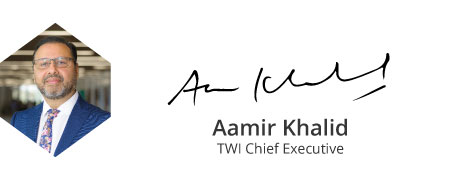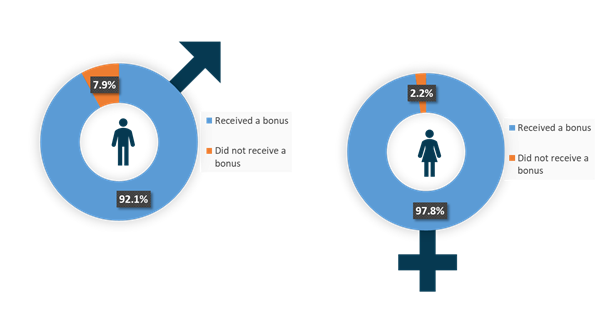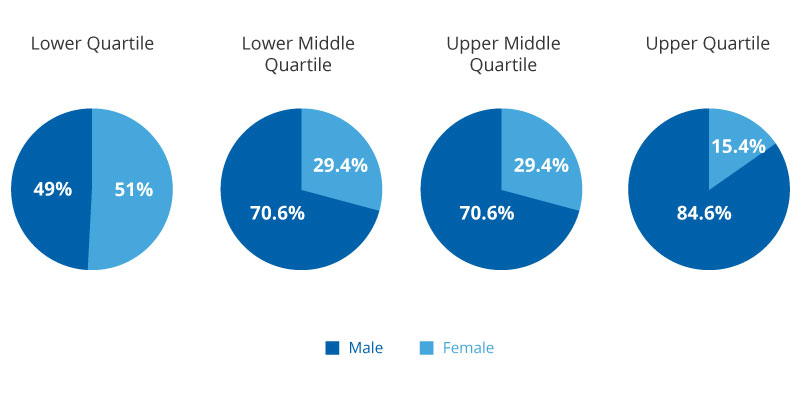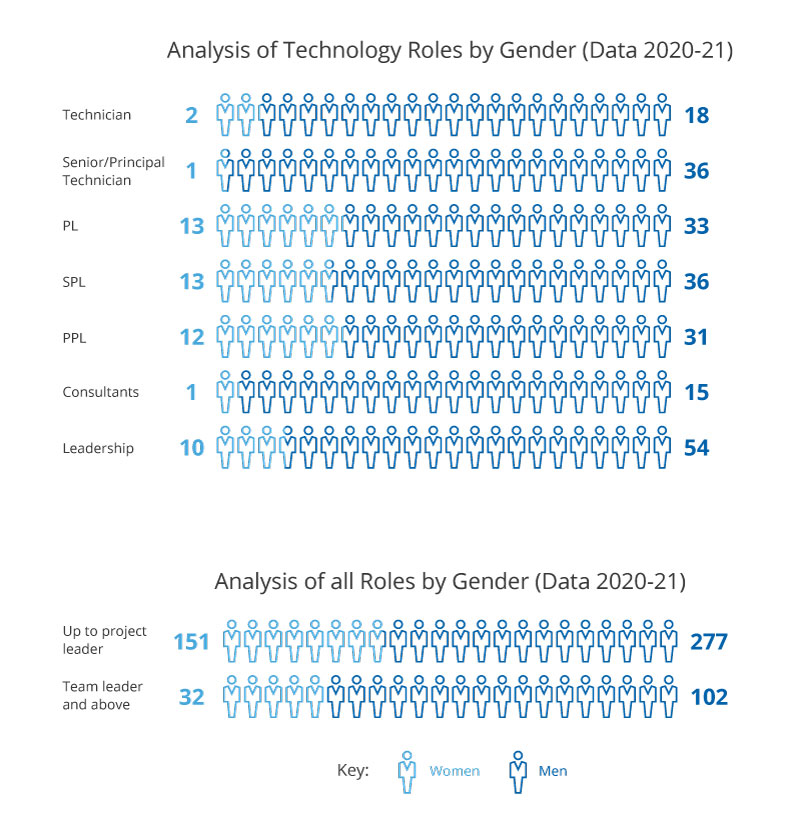TWI people are the cornerstone of our business. The work they do plays a crucial role in shaping the world around us, interacting with our Members and customers to find solutions to the biggest engineering challenges our world faces in becoming resilient and sustainable. In a world that is both diverse and connected, our people must reflect the society we seek to serve and that is why closing the Gender Pay Gap has become a focal point in our 5 year corporate strategy.
The engineering profession has been predominantly male. In the UK engineering sector, just 14.5% of employees are women and only 16% of UK engineering graduates are women. The percentage of women in technology roles at TWI is 19%, the highest it’s been since we started reporting in 2017. Nevertheless, there is still work to be done to increase women technologists at TWI, especially in leadership positions. With only 16% of technology leadership roles performed by women (24% representation of women in our leadership roles across all disciplines) we have committed to have a third of leadership positions filled by women by 2025.
We recognise that our progress to close the Gender Pay Gap has been slow and the pandemic resulted in a pay freeze in the reporting period, which inhibited our ability to effect change through the pay review process. Nevertheless, we are committed to finding ways to closing the gap and to create more opportunities for talented women to thrive at TWI. Hence, we are making bold commitments within our latest 5-year strategy on diversity and inclusion. We are committed to reducing our Gender Pay Gap from 23% (GPG figure for 2022) to 10% or less by 2026 as well as having a third of leadership roles occupied by women by 2025. We know that to achieve this ambition, we need the whole organisation to play their part. We have cascaded these objectives via our balanced scorecard and appraisals. In 2022 we aim to reduce our Gender Pay Gap by 3%, setting such measures will drive accountability and link progress to our number one corporate value of inclusion.
The imbalance of women in engineering roles requires investment at an early stage and TWI is actively seeking opportunities to support development and recruitment of women engineers. We are particularly proud of our NSIRC programme; engaging graduate engineers to complete postgraduate studies within TWI and provide exposure to industrial challenges. 32% of TWI’s current post-graduate students are women. During this reporting period, we recruited further female NSIRC students on to our programme and out of the 21 NSIRC postgraduates who completed their PhD, 29% were women.
In 2021, we launched a ‘Living our Values’ campaign to bring each of our six corporate values to life by exploring with staff the behaviours that underpin each of our corporate values. We invited all TWI employees from across the globe to participate in focus group sessions to ensure that everyone was given an opportunity to shape our organisational culture change. We are taking forward a number of actions in response to the feedback from this initiative. One of the actions that we are delighted to have introduced in 2022 is a move to hybrid working, albeit hastened by the pandemic, staff told us that hybrid working is instrumental in providing a work/life balance for parents and carers, which disproportionately fall on women. Greater flexibility to choose a work-life balance allows women to thrive both in and out of the work place.
It is important to state that at TWI we want to make sure that employees in similar roles are being paid equally. However, we acknowledge that we do have a Gender Pay Gap that needs to be addressed, similar to other engineering organisations across the UK. Our mean figure for this year’s reporting date (April 2021) is 22.3%, a 0.9% decrease from last year. Our Gender Pay Gap is reflective of the proportion of men and women in specific roles that attract higher pay, bonuses and allowances. The progress made to reduce the gender pay gap between 2020 to 2021 (reporting year) along with TWI’s long-term plan to address our Gender Pay Gap is outlined in this report.
We recognise we have to make significant changes to close the Gender Pay Gap and remain committed to achieving positive change. We are confident that our Diversity and Inclusion plan will enable us to make TWI an inclusive organisation.
Declaration
I can confirm that the data and information reported as of 31 March 2022 is accurate.

See our gender equality plan here:
Gender Equality Plan
Gender Pay Gap (GPG) Reporting
Under legislation brought into force in April 2017, UK employers with more than 250 employees are required to publish their Gender Pay Gap (GPG). We are now in our fourth year of publishing data. This report is based on TWI’s UK employees and is an analysis of a data cut from April 2020.
Gender Pay Gap (GPG) is distinct from equal pay. Equal pay deals with the pay differences between men and women who carry out work of similar value, whereas GPG shows the differences in the average pay between men and women. The following GPG analysis shows the differences in the average pay between men and women across all UK employees at TWI, irrespective of their responsibilities, performance and experience.
TWI carries out a separate pay review on an annual basis, with external benchmarking, to ensure men and women within the company, with the same performance and experience in equivalent roles, are paid equally.
The Difference between the Hourly Pay of Women and Men at TWI
Our figures for the reference pay period (the 12 months prior to April 2021) show that when we compare the average pay of women and men, irrespective of the role, men earn on average 22.3% more than women.
The table below outlines the mean and median difference in hourly pay between men and women within this reporting period:
Hourly Pay
|
|
The Mean Gender Pay Gap
|
22.3%
|
| The Median Gender Pay Gap |
27.9% |
Bonus
|
|
The Mean Gender Pay Gap
|
3.3%
|
| The Median Gender Pay Gap |
0.0% |
| |
|
| The proportion of males and females receiving a bonus |
| Males |
92.1% |
| Females |
97.8% |
The mean gender pay gap across our UK business declined slowly from 2018-21, changing by 0.3-0.9% in each of the reporting periods.
The reasons for the differences in hourly pay between men and women are:
- There are fewer women than men in leadership roles, i.e. the executive team, senior management, senior business development and senior specialists (see graph below: Gender by Group).
- There are more women than men in support roles.
- During this reporting period, women made up 33% and men made up 67% of the working population at TWI and the Technology Group employed fewer women than men as engineering professionals (19% and 81% respectively), which typically have higher salary than support roles. Nationwide, women remain under-represented in engineering, with only 14.5% of engineering professionals being female compared with an overall 48% women in the UK workforce (Engineering UK).
- The investment TWI is making in recruiting women at the entrance level, particularly postgraduate engineers from NSIRC, will increase the disparity in the percentage gender pay gap in the short term. However, we will see a closure in this gap provided more women progress into senior roles.
The Difference in Bonuses between Women and Men at TWI
During the reference pay period for this report, share-in-success bonuses were not paid due to the ongoing financial impacts of the coronavirus pandemic. However, a one off thank you bonus was paid to qualifying staff.
The chart below shows the proportion of employees receiving a bonus, 92% of men and 98% of women. There is a difference in numbers of bonuses between men and women due to there being a higher proportion of men being on zero hour contracts and therefore not qualifying for a bonus payment.

The Difference in Promotions between Women and Men at TWI
Due to the financial impacts of the coronavirus pandemic, we enforced a pay freeze for a majority of this reporting period. However, 22 promotions were awarded during the reporting period with 27% of those promoted being women.
Our Commitment to Increase Gender Diversity in Leadership Roles at TWI
Analysis of TWI employee data during the reporting period shows that female representation amongst our technologist Project Leaders (PLs) was 28%, for Senior Project Leaders (SPLs) it was 27% and amongst Principal Project Leaders (PPLs) it was 28%. 6% of Technology consultant roles are filled by women, which is a decrease since the last reporting period, and the representation of women in technologist leadership positions has decreased by 4% to 16%, although this is equivalent to only 2 members of staff. Leadership is defined by Team Leader level and above. We recognise a need to improve on progressing women into leadership positions and this challenge is at the heart of the on-going review and revision of career progression routes within TWI.

The charts below show how women and men are represented by Job profile within TWI.

Progress with our Action Plan during 2020 – 21
Addressing the Gender Balance from the Top
TWI’s action plan to address Gender Pay gap is embedded in the 5 year strategy. TWI has started by reviewing the gender balance at the governance level of the organisation. Since TWI’s forerunner British Welding Research Association (BWRA) was established in 1946, there were no female representatives on the governing Council. In 2017 the CEO and Chair of Council made the decision to recruit 2 women into positions on Council and there were 3 women on Council in the reporting period, together with 24 men, giving 11% female representation. While the percentage has not increased since the last reporting period, our aim is for female representation on the Council to increase. We are actively seeking to attract a greater female applicant pool.
Organisational Design
To ensure inclusive recruitment and progression opportunities across TWI, our Organisational Design Working are creating an organisational design framework that enables transparent succession planning for all areas of the business. Implementing an organisational design framework will support our commitment to create a more diverse workforce through clear career pathways and succession planning.
The organisational design framework will include:
- Defining the organisational design to define the best working structure for TWI
- Aligning the job profiles to match the organisational structure
- Job profiling
- Salary benchmarking
- Talent Gap Analysis and determining future workforce needs
- Succession planning – using appraisals and Nine-box Grid
- Create career pathways for progression for five strands of the business: management/ technology specialist/specialist other/technical support/administration
- Create a mentor programme
It is envisaged that the organisational design framework will be rolled out globally.
Mentoring Programme for Women
We launched our ‘Women In Leadership’ programme in November 2019, with the aim being to equip women with the tools, self-awareness and increased confidence required to identify ‘big picture’ opportunities, to seek personal advancement by taking on more responsibilities and ultimately to gain well-earned progression.
Three cohorts of women have completed this programme. The feedback received for this programme has been extremely positive with the women scoring their coaching at 6.9 out of 7 via a coaching feedback system. This score is highly encouraging with over 20% of attendees being promoted since the course started in 2019.
Encouraging more Women into Science, Technology and Engineering Careers through Outreach Initiatives and NSIRC
Under-representation of women in science, technology, engineering and maths (STEM) subjects during education puts a crucial limit on gender representation across the Engineering industry. According to a 2020 report from the Royal Academy of Engineering, in 2015-16, 15.6% of first degree qualifiers in engineering related degrees were female and at April 2018, only 9.3% of the UK engineering workforce were women. Two of the four key learnings from the report were ‘(1) students from underrepresented groups need active encouragement and social capital to increase success in accessing engineering employment and (2) long-term face-to-face intervention is necessary to promote relationships between students from underrepresented groups and employers in the sector to change both student and employer perceptions, behaviours and employment outcomes.’ A 2020 report from Engineering UK further highlighted that just one in 5 of all engineering and technology entrants into the UK engineering industry were women in 2018 to 2019.
TWI has invested in STEM education and outreach for over 15 years and are pleased to support and provide a number of outreach activities and networking opportunities for women who have the skills and attributes to forge a successful career in engineering. During the reporting period, our ability to deliver our usual programme of work experience placements, summer placements and internships was severely impeded by the restrictions placed upon us by the pandemic. We look forward to welcoming our engineers of the future back into the workplace in 2022.
Our dedicated outreach team worked hard to redesign our programme offering, so that we were still able to deliver parts of our programme virtually. Our STEM champions were involved in the following outreach activities during this reporting period:
- 1:1 mentoring sessions for University students studying associated STEM disciplines
- Acting as facilitators to conduct mock interviews with secondary school pupils interested in STEM careers
- Technical presentations to University students
- Delivery of careers talks at various careers fairs
Review of Our Recruitment Practices in 2020 – 21
Since the last reporting period, we have continued our commitment to fair and transparent recruitment practices which include:
- Interview panels are required to include both genders in at least one stage of the interview process
- Job adverts have continued to be checked with a gender decoder tool to ensure that they do not include any unconscious bias that could potentially discourage applicants
- All recruiting managers receive training on inclusive recruitment practices
- Continue to develop a range of initiatives, programmes and policies to improve diversity and inclusion and enable women to fulfil their career aspirations.
A Review of the Working Culture at TWI
As a global membership research and technology organisation, with a far-reaching geographic and technological footprint, we are dedicated to utilising our diversity to serve our Members. Inclusive business practices are vital to allow us serve our Members to the best of our collective and diverse abilities. This is fundamental to effectively transferring our technology to our customers around the world.
We have recently reviewed our approach to Diversity & Inclusion and have embedded this into our 5-year corporate strategy. We are dedicated to creating a safe and inclusive workplace for all staff irrespective of their protected characteristics. This includes fair processes for development, performance management and progression, and the creation of a more diverse and representative Council.
Equality, Diversity & Inclusion training will be rolled out to our 800+ employees in 2022. This includes all employees being invited to complete an Insights Discovery psychometric assessment so they are better informed to understand themselves and to help them interact more effectively with their peers.
TWI, March 2022